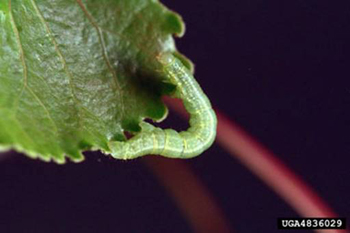DACF Home → Bureaus & Programs → Maine Forest Service → Forest Health & Monitoring → Forest Pest Index → Bruce Spanworm Operophtera bruceata (Hulst)
BRUCE SPANWORM
Operophtera bruceata (Hulst)
Damage

This pest of forest and shade trees occurs throughout the northern United States from New England to the Great Lakes where it is a periodic defoliator of a variety of hardwood trees. Damage is first noticeable in early May when feeding by the tiny larvae known as "cankerworms," "inchworms" or "measuring worms" on the opening buds and expanding leaves causes the foliage to be skeletonized. Later, as the larvae mature, all but the midrib (and veins) of leaves are devoured.
Outbreaks are most often localized and usually last three to four years before natural control factors such as parasites, predators and disease cause the population to collapse. Trees subjected to two or more years of heavy defoliation may exhibit noticeable growth reduction, especially those that are weak or growing on poor sites. Heavy defoliation of sugar maple may result in some reduction of sap flow or sugar content.
Hosts
In Maine its preferred hosts are maples and poplars but will also occur on willow, beech, white birch, red oak, pine and choke cherries.
Description and Habits
The adults emerge from the duff in October and November. Females are grayish-brown and wingless. Male moths are light brown with a one inch wing span. Their wings are thin, semitransparent, and banded with numerous brown or gray scalloped lines. The females crawl up and deposit their eggs singly in the trunk and branches of host trees. Overwintering eggs turn bright orange in color and hatch in late April or May at about the same time that the buds begin to open. The Bruce spanworm larvae or "cankerworms," first feed by boring into swelling buds and young expanding leaves causing the foliage to appear tattered or ragged. As the cankerworm mature over the next five or six weeks, they darken from pale yellow green to dark green or brown and devour all but the midrib (and veins) of leaves. Full grown cankerworms are about one inch long, and have three pale yellow stripes along each side. By mid- to late June, the cankerworms drop to the ground and pupate in the soil to reemerge in the fall as adult moths.
Larvae of this species which have two pairs of fleshy legs near the end of the abdomen and move about with a looping motion are apt to be confused with two other species of cankerworms, inchworms, or loopers which are also pests of hardwoods - the fall cankerworm, Alsophila pometaria, and the spring cankerworm, Paleacrita vernata (Peck). Like Bruce spanworm, the larval stage of these two is basically green to brownish, 3/4 to 1 inch long and move about with a looping motion. The fall cankerworm feeds principally on oak, elm, and apple, and may be differentiated by its egg masses which are grayish-brown and neatly arranged in uniform rows on the smaller branches and twigs of trees, and by the number of abdominal legs (3 pair). The spring cankerworm is very similar in appearance to the Bruce spanworm but feeds principally on elm and apple and may be differentiated by its eggs, which are deposited in the spring in loose clusters on the bark of the trunk and larger branches.
Control*
Control of Bruce spanworm is not usually necessary but can be achieved by spraying the trees with a registered pesticide soon after the larvae first become active and after the leaves have become sufficiently expanded for coverage by the spray. Materials registered to control cankerworms in May or June include the following: carbaryl, acephate, and Bacillus thuringiensis (Bt), a microbial product. Be sure to refer to the pesticide label for specific use instructions.
*NOTE: Pesticide recommendations are contingent on continued EPA and Maine Board of Pesticides Control registration and are subject to change.
Caution : For your own protection and that of the environment, read the insecticide label and observe all hazard and warning statements.
MAINE DEPARTMENT OF CONSERVATION
Maine Forest Service - Forest Health and Monitoring Division
April 2000
For More Information:
BugWood Wiki